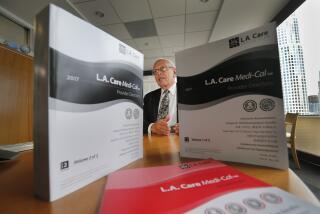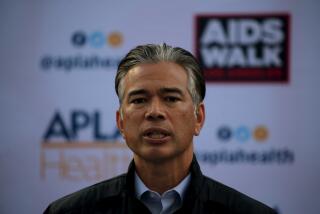Privatization Helps Cure Clinic Problems : Health: Doctors and the county have teamed up to enable medical facilities for the poor to become more efficient and profitable.
An unusual partnership between private doctors and county government has resulted in a dramatic turnaround for Ventura County neighborhood medical clinics, according to county health officials and doctors.
Three years ago, the Ventura County Board of Supervisors almost closed the county’s four family care clinics, which provide basic medical services to the poor at minimal or no cost. Although they served nearly 20,000 patients annually, the clinics ran close to $1 million in the red each year.
For the record:
12:00 a.m. Sept. 3, 1992 For the Record
Los Angeles Times Thursday September 3, 1992 Ventura County Edition Metro Part B Page 4 Column 1 Zones Desk 1 inches; 25 words Type of Material: Correction
Wrong number--An article Sunday incorrectly reported the daily number of patient visits to Las Islas Family Medical Group in Oxnard. Officials said the correct figure is 130.
An enterprising group of doctors intervened with a unique idea for saving the clinics, and today the system is self-sufficient and serving more patients than ever, the officials said.
That idea can be explained in one word: privatization.
Three of the county’s four clinics have become semiprivate corporations, distinct from the government that spawned them but still charged with providing care to anyone who walks through the door. Plans are in the works to convert the fourth, in Simi Valley, next year.
In each clinic where the county has relinquished control, care has been improved, the clinics themselves have grown, patient-doctor relationships have been strengthened and the county has saved hundreds of thousands of dollars, county health officials and patients said.
Officials say there are two key reasons for the success of the new system: It provides a profit incentive for the doctors and it frees them of unnecessary bureaucratic controls.
“Everybody’s a winner,” said Phillipp Wessels, director of the Ventura County Health Care Agency and one of the principal designers of the public-private partnerships. “The patients are getting better care, taxpayers are no longer paying a subsidy, and the physicians are pleased with their practices.”
Wessels said he is not aware of any other counties in California that have privatized their clinics, although some have called him about the idea.
While the public-private partnership works well in Ventura County, it may not be viable in more urban areas, said Larry Roberts, deputy director of the Los Angeles County Department of Health Care.
“It depends on the situation,” Roberts said. Ventura County doesn’t have the same demand as Los Angeles, he said, and it has a Board of Supervisors that is willing to take chances.
Los Angeles County has used private contractors for health services in the past with mixed results, Roberts said. But he added that Ventura County’s unique blend of public support and private entrepreneurship is intriguing.
“We will be monitoring it,” he said. “Given the shortfall in the state budget, we may have to look at the way we do business as well.”
The newly privatized clinics are supported by the county in a number of ways. The county holds the leases, guarantees the doctors’ first year of salary, and provides general hospital services through the Ventura County Medical Center.
But as with private clinics, the doctors now follow their patients through a hospital stay. They are responsible for hiring their own staff, balancing their own budgets and tending to their own bottom lines.
Since the switch, the bottom line has been impressive. In 1991, the Oxnard clinic (Las Islas was built last summer) cost the county $300,000. Only 10 patients came through its doors each day. This year Las Islas sees 30 patients a day and will boast an estimated profit of $168,000, according to Wessels.
Last year, the county’s Santa Paula neighborhood clinic operated at a $46,185 loss and saw 5,293 patients. This year it is projected to earn a $69,000 profit while serving 11,800 patients, Wessels said.
The Ventura clinic posts similar numbers. It lost nearly $125,000 two years ago, but is earning a $58,000 profit this year. Patient load has almost doubled.
The changes have been dramatic for many poorer patients who, because they are on government programs like Medi-Cal, were accustomed to long waits and spotty care.
“It was better here, because it’s close to me and the doctors were nicer,” said Lupe Ponce, 24, as she cradled her newborn in a waiting room at Las Islas. Compared to county-run clinics, she said, the doctors at Las Islas are more attentive and caring. “They tell you about possible problems before they happen,” she said.
“We are taking the health care dollar and spending as much of it as possible on providing care,” said Dr. Nat Baumer, who with his wife, Dr. Joan Baumer, runs the west Ventura and Santa Paula clinics.
Because the semiprivate clinics retain their status as public health care providers, they are paid a premium by the state for each Medi-Cal patient they see, Joan Baumer explained. That makes the clinics financially viable.
“We still need the county label for funding,” she said. “If you are a private practice, you don’t get paid as much by Medi-Cal.” Profits are plowed back into providing more services, she added.
Nat Baumer, who also serves as the director of the emergency room at Ventura County Medical Center, said the new public-private partnership encourages teamwork among the clinic staff.
Salaries of doctors and staff members are tied to their performances, not to a county pay scale. Routine decisions of spending, staffing and administration are handled by the doctors, not an unwieldy county bureaucracy.
“The way we used to do business needed to be repaired,” said Pierre Durand, administrator of the Ventura County Medical Center. The new clinic system was a risk, he said. “This was something that was not consistent with how government usually runs.”
The result, doctors say, is a more efficient operation capable of providing better long-term care.
“Let’s say I want dictation because I know if I could dictate my notes, I would have more time to see patients, and therefore bring in more money,” said Dr. Brian Prestwich, a staff doctor at the west Ventura clinic.
“With the old system, I would have to fill out a bunch of county forms and wait two months,” he said. “And I would be competing with a hundred different requests from a hundred different people.”
With the new system, Prestwich simply explained to Nat Baumer that dictation would save the clinic money. He got it immediately.
The new clinics also save the county money. Overburdened and understaffed, the old system often referred sick patients to the emergency room, where costs are dramatically higher, Prestwich and other doctors said.
But since the new system was put in place, the clinics have added new doctors and extended their hours into the evenings and through lunch. As with private clinics, strong doctor-patient relationships are stressed. When patients feel sick, they call their personal doctor first.
“We keep them out of the emergency room and in better health,” Prestwich said. “In the long run, that saves the county huge amounts of money.”
Nat Baumer said the benefits of the new system have been reflected in the county emergency room. “The number and types of visits to the emergency room have declined,” he said. “People get better care when there is continuity between doctor and patient.”
Private clinics, especially those that specialize in serving the Medi-Cal population, already know that. Designed to fill the void left by inconsistent government care, some private facilities are nervous about competing with streamlined county outfits.
“There is nothing wrong with competition,” said Al Limon, program coordinator for Clinicas del Camino Real, a network of private clinics in Ventura County. “But when government competes with small business, then you have to question what is the role of government.”
Limon points out that the newly incorporated clinics were given start-up money from the county, and that the doctors’ salaries were guaranteed for the first year. “That is not a level playing field,” he said.
County administrators counter that they are making the best use of government dollars. “We are maximizing what money we have,” Wessels said. “Our focus is serving the maximum number of people.”
More to Read
Sign up for Essential California
The most important California stories and recommendations in your inbox every morning.
You may occasionally receive promotional content from the Los Angeles Times.










